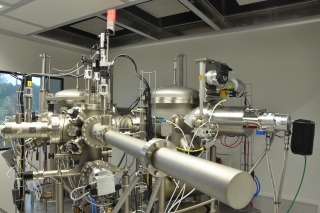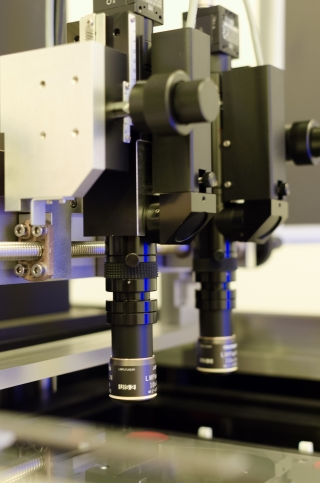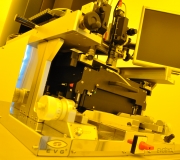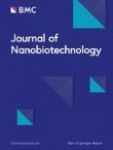
The Cleanroom Laboratory is designed and maintained in accordance with the standards: ISO 14644-1: 1999, ISO 14644-1: 2015 and EU GMP (Guide to Good Manufacturing Practise).
In addition to the following laboratory equipment, important in the NBMC Cleanroom laboratory are also: cloakroom (room 0/6d), "clean" corridor (room 0/6f), "dirty" corridors (room 0/6g and 0/6h, serving as a technical back-up facility with necessary utilities) and airlock: two pressurized and one rotary (necessary for proper air circulation between clean zones, regulation of working pressures and ensuring an appropriate sanitary and sterile regime).
Cleanroom A (room 0/6a)
Ultra High Vacuum machine (UHV) for evaporation of materials
- Two growth chambers for the deposition of metallic layers (magnetic/nonmagnetic) with load-lock system
- UHV system equipped with cryogenic pumps (< 5x10-9 mbar)
- Electron gun (Telemark, 6 crucibles x 7 cm3)
- Ion gun (Tectra) to clean the substrate before evaporation process
- UHV manipulator:
- diameter of wafers: 0,2” – 4” (different shapes)
- substrate-vapor source angle: +/- 50°
- adjustable speed rotation of the substrate
- source rotation resolution: 1°
- substrate-vapor source angle: +/- 50°
- adjustable speed rotation of the substrate
- source rotation resolution: 1°
- Thickness gauge and evaporation rate measurement system
Bruker's Innova Atomic Force Microscope
Scan ranges up to XY= 90 mm2 , Z=7.5 mm and 5 mm2 Z=1.5 mm, unique closed-loop scan linearization system, atomic resolution.
Available modes: Contact Mode (air), Tapping Mode (air), PhaseImaging, Lift Mode, Magnetic Force Microscopy (MFM), Electrostatic Force Microscopy (EFM), Dark Lift, Lateral Force, Microscopy, Nano-Indentation, Scanning Tunneling Microscopy STM, Low Current STM, Conductive AFM, STM with EC, Contact and Tapping Modes with EC, Surface Potential, Piezoresponse, Scanning Capacitance, Force Modulation.
Available modes: Contact Mode (air), Tapping Mode (air), PhaseImaging, Lift Mode, Magnetic Force Microscopy (MFM), Electrostatic Force Microscopy (EFM), Dark Lift, Lateral Force, Microscopy, Nano-Indentation, Scanning Tunneling Microscopy STM, Low Current STM, Conductive AFM, STM with EC, Contact and Tapping Modes with EC, Surface Potential, Piezoresponse, Scanning Capacitance, Force Modulation.
Cleanroom B (room 0/6b)
Reactive Ion Etching (RIE)
- RIE-system for the processing of up to 200 mm diameter wafers equipped with RF paralel plate plasma source
- Plasma source: 13.56 MHz, 600 W
- Load-lock system
- Gas lines: Ar, O2, SF6, CHF3
- Vacuum system: turbo molecular pump with banking pump
- System design is configured for downstream processes under the use of oxygen, fluorine or chlorine containing gases
- Standard recipes for etching processes of silicon containing materials (Si, SiO2, Si3N4)
- Homogeneity deviation: < +/- 3% over 100 mm substrates
- Repeatability of the process: < +/- 3% over 200 mm substrates
- SiO2 etching rate> 0.1 mm/min
Atomic Layer Deposition System (ALD)
- The reaction chamber "top-flow" (uniform, vertical gas flow orthogonal to the substrates), integrated in a vacuum chamber, heated
- Precursors sources:
- for solid state precursors
- for liquid precursors
- for solid/liquid precursors (up to 300°C)
- for liquid precursors
- for solid/liquid precursors (up to 300°C)
- Max. temperature of the proces: 500°C
- Size of wafers: up to 200 mm x 10 mm
- 3D substrates: up to 150 mm x 120 mm
- Gases: nitrogen, argon
- Load-lock system
Cleanroom C (room 0/6c)
Mask aligner with spin coater
- Exposure modes: without a mask, the top centered, proximity (adjustable slots: 1-300 mm), "soft-contact" (adjustable pressure: 0.1-40N), "hard contact" (pressure regulation), "vacuum contact "(adjustable vacuum level)
- Precisely control table
- Digital microscope:
- manual
- high-resolution CCD camera
- 2 lenses (10x)
- digital zoom (4x)
- high-resolution CCD camera
- 2 lenses (10x)
- digital zoom (4x)
- Optical system (NUV)
- Substrate handles (Ø 100, 150 mm) and masks handles (Ø 125, 175 mm)
Cleanroom D (room 0/6d)
Wire Bonder 53xx BDA
- The bonder 53xx BDA (Ball Deep Access) from F&S Bondtec can be used as a thin-wire ultrasonic ball-wedge bonder for gold wires when software version 5310 is selected, or as a deep-access wedge-wedge bonder for aluminium and gold wires if software version 5332 is selected,
- Special design of the bondhead. This design makes the bonder highly versatile in terms of adaptability to material and application. Changing from one bond process to the other is a straightforward process involving merely the quick and easy replacement of the bonding wire and the bond tool,
- Ready for use as soon as the appropriate bonder software has been started,
- Ability to bond ribbon wires from 30 to 250 μm width,
- Operating temperature: 18-24.5°C,
- Relative humidity: 45% +/- 10% abs., no condensation,
- Supply voltage: 115 - 230 V AC,
- Voltage frequency: 50 - 60 Hz,
- Installed load: 230W,
- Noise emission: <70dBA,
- Vacuum: <300 mbar (outside Ø 6 mm).























